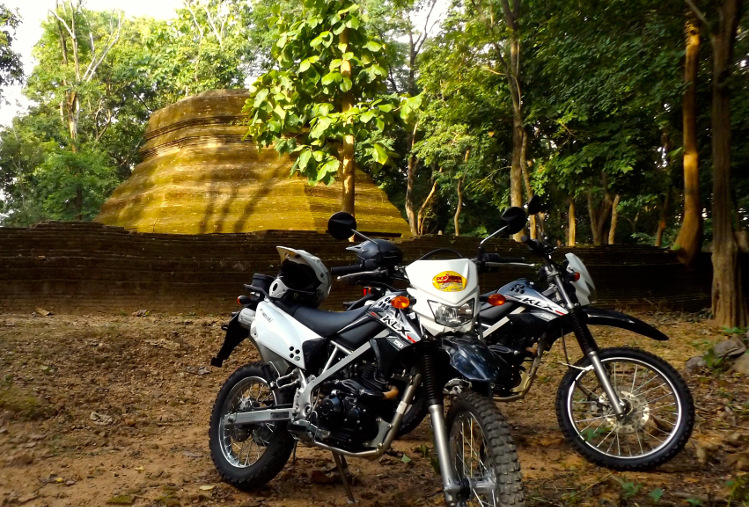Begin the trip in the northern Thailand tourist hub of Chiang Mai. From here riders can choose to travel the Mae Hong Son loop in a clockwise direction by heading south from Chiang Mai towards Hot along route 108 (an ideal choice if you're still building confidence as a rider), or anticlockwise via the more challenging route 107 north to Chiang Dao – you won’t miss a thing either way. The loop can be completed in a minimum of four days, but the more time you have, the better. Here’s our roundup of the best stops along the way.
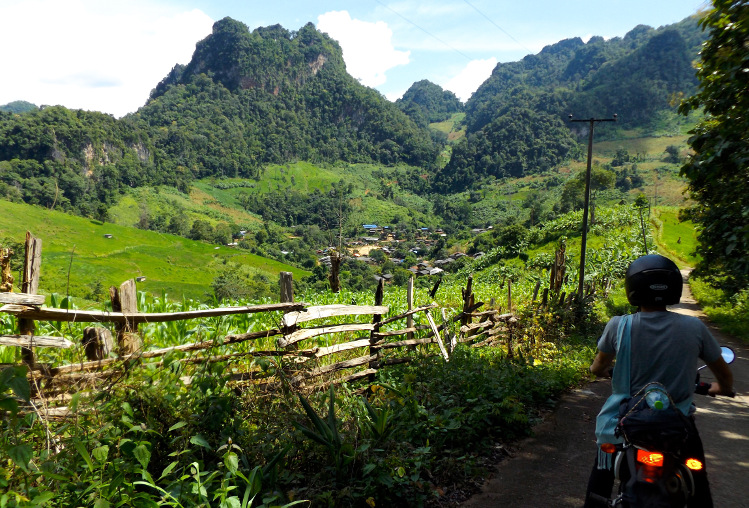 Motorcycle rider taking in the view of the Mae Hong Son loop, Thailand. Image by Jack Southan / Lonely Planet
Motorcycle rider taking in the view of the Mae Hong Son loop, Thailand. Image by Jack Southan / Lonely Planet
This magnificent stretch of road north of Mae Rim really sets the scene for this journey. Although many riders taking the north route head straight to Pai, the 80km deviation to Chiang Dao, a sleepy town nestled amongst a ring of vast limestone cliffs, is well worth the effort. The tarmac on this stretch, which winds its way through open expanses of verdant farmland and dusty towns, to sky-high gorges and vine-covered rocky outcrops, is in great condition, which is helpful if you’re still getting used to being on a bike.
One of the main highlights of Chiang Dao, known as the ‘City of the Stars’, is the awe-inspiring cave complex about 5km out of town. It has more than 12km of stalactite-strewn tunnels to wander through. Some you can explore on your own, while others need a guide and a lantern (100B/pp). The town itself feels forgotten, and receives little in the way of tourism, yet there are some decent cafés and guesthouses within the vicinity.
The turnoff to Pai and route 1095 is where the real bikers’ paradise begins – 762 bends wind their way through the steep mountain trails, over hills and through river valleys. The curves are tight and often slippery or gravel-strewn, so take it slow. The descent into Pai itself – through paddy fields so green they almost glow – is wonderful. There are loads of places to eat, drink and sleep here – Sabai Garden Bungalows (8 Th Wiang Tai) on the outskirts is a good option. If you’ve got a spare day or two up your sleeve you won't have any trouble whiling them away at Edible Jazz, eating Tom yum soup and drinking strong cocktails at sundown.
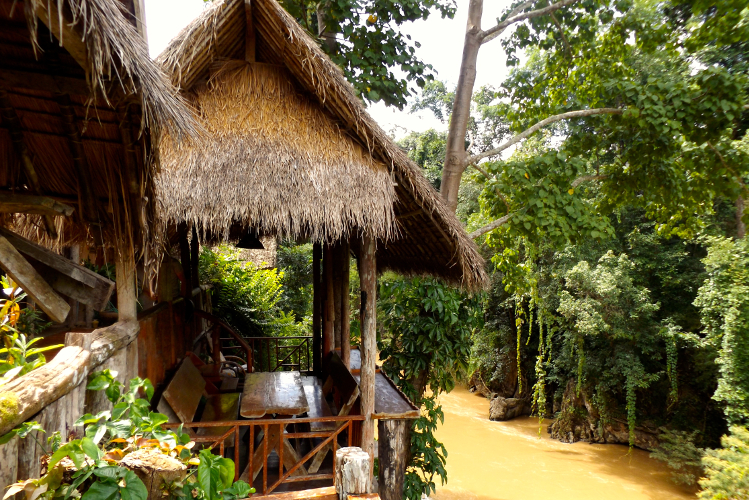
The most scenic stretch of road on the loop lies just beyond Pai – think sharp hairpins and epic panoramas, across a landscape that could be mistaken for the set of Jurassic Park. Charming little Soppong is worth a stop, if just for a coffee. A muddy river runs along the lower flank of the town, which is lovely to watch from the precariously cantilevered terrace at the Soppong River Inn. With a ‘20s jazz soundtrack wafting down from the cafe it’s an ideal spot to recuperate. Rooms are available from 500B if you feel like staying on to do some trekking in the area.
Sixteen kilometers outside Mae Hong Son, just after the turnoff to Fish Cave, is a small right fork onto a concrete road. Turn off and glide through the paddies toward the Chinese outpost village of Mae Aw, also known as Ban Rak Thai, right on the border with Myanmar. A short while into the 40km stretch, the scenery will feel reminiscent of medieval China; tea plantations are laid out across the wild scrubland in a patchwork of browns and dark greens, Mandarin scripture covers wooden teahouses and, as you reach the village itself, a serene glassy lake comes quietly into view. Get yourself a steaming cup of Chinese black tea and enjoy the tranquility. Guesthouses on the lake cost from 300B – Ping Ping Guest House is an ideal spot to relax.
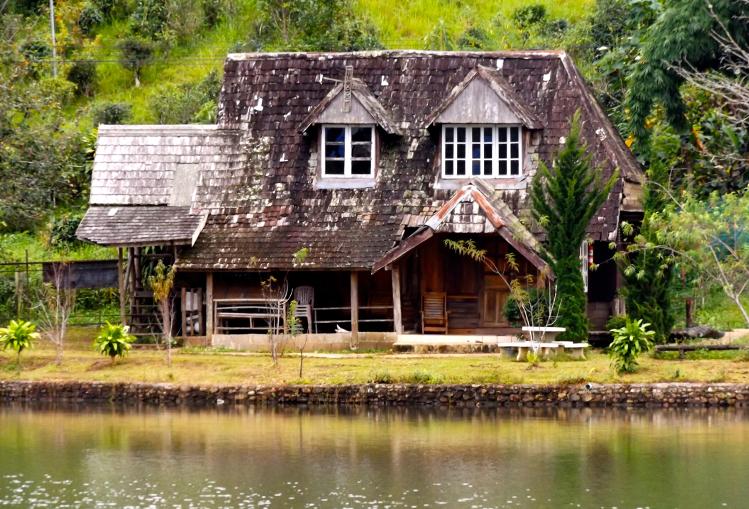
Once you hit Mae Hong Son town ('City of Three Mists') the road seems to level out. Hairpins change into sweeping racetrack curves, which are exceptionally fun to ride. The city itself is not hugely popular among Western backpackers; instead it tends to attract Thai and Chinese holidaymakers. There are guesthouses and restaurants surrounding the banks of Jom Kham Lake and the town is a good base for day rides.
Khun Yuam, 85km south of Mae Hong Son town, is a stopping point for one main reason: a moment of deliberation. Continue south and onto the open plains of Mae Sariang or head inland on route 1263? The former is much easier, yet the latter is a terrific adventure – granted you have good tyres and decent suspension. A rough and inhospitable stretch thanks to large potholes and rocks, it’s tough riding.
Mae Chaem is the last chance saloon town before the long climb to the summit of Doi Inthanon, Thailand’s tallest mountain. It’s a good spot to refuel both the bikes and yourself for the evening. There are very few places to stay here, but the Mae Chaem Resort, just off the main strip, is comfortable and clean, and it even has a swimming pool.
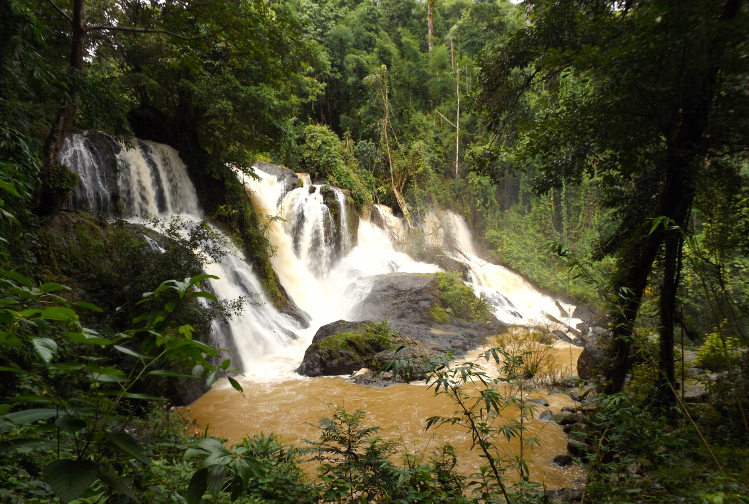
It can be a misty ride up to the mountain summit, especially in rainy season, but the wide, open roads make it easy to navigate for the most part. A very steep route carves its way through a swathe of cool forest and if the weather is clear at the summit you’ll be in for a magnificent spectacle. If it’s cloudy (as it often is) the view may be a little underwhelming. But we think it’s worth the risk.
It’s a simple ride back to Chiang Mai on the overwhelmingly uninteresting route 108, but that said, it does give you time to reflect on that epic journey behind you.
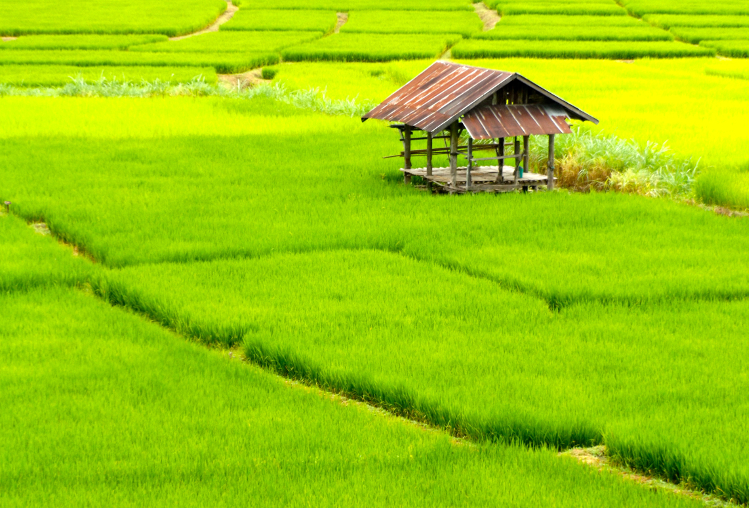
Take your time when choosing a bike to rent. Chiang Mai is the best place to look as it has an enormous variety of shops and rental outlets offering similar hardware. Bigger is usually better on this kind of ride, but check your insurance to see what engine size you’re covered for. I opted for a Kawasaki KLX150 off-road bike (for its excellent suspension and ride quality) from POP Motorcycle Rent (Kotchasan Road) at a cost of 3000B for seven days. Other bike shops worth checking out in Chiang Mai include Marble Motorcycle For Rent (131/2 Moon Muang Rd) and Tony’s Big Bikes (17 Ratchmamanka Rd). Prices range drastically for different bikes, you can pay anything from 3000B to 15000B.
